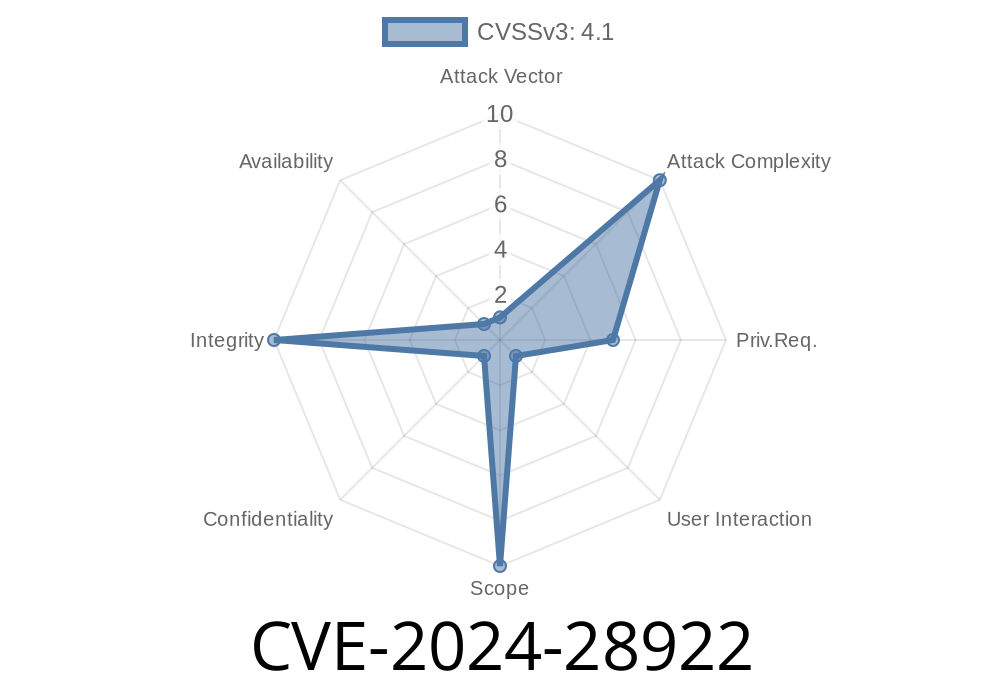In early 2024, security researchers discovered a critical vulnerability tracked as CVE-2024-28922 that affects Secure Boot, a key security feature in many modern systems, particularly those built on Windows and UEFI firmware. This vulnerability allows attackers to bypass Secure Boot protections and execute unauthorized code during the boot process—potentially leading to complete system compromise.
In this article, we'll break down what Secure Boot is, how CVE-2024-28922 works, provide an exploit example, and give practical guidelines for defense. We'll keep the content beginner-friendly and direct.
What is Secure Boot?
Secure Boot is a security standard designed by the PC industry to help make sure that a device boots using only software that is trusted by the Original Equipment Manufacturer (OEM). When the PC starts, the firmware checks the signature of each piece of boot software, including firmware drivers and the operating system. If the signatures are valid, the PC boots, and the firmware gives control to the operating system.
The Problem: Bypassing Secure Boot (CVE-2024-28922)
CVE-2024-28922 is a Secure Boot security feature bypass vulnerability disclosed by Microsoft in March 2024.
In plain words:
An unauthorized attacker with physical or local access could exploit this vulnerability to load untrusted or malicious bootloader code, completely defeating Secure Boot's main purpose. As a result, malware can run before the operating system starts, potentially disabling antivirus or hiding itself from security tools.
Root Cause
The core issue lies in the improper validation of certain boot-related files. An attacker can manipulate bootloader files, leveraging flaws in signature verification or in the boot chain process, eventually allowing unauthorized code to slip through Secure Boot's protection.
Exploit Details
> Note: Exploiting this vulnerability requires physical or privileged local access. It's especially dangerous in environments where threat actors can get hands-on with machines, such as cloud-hosted VMs, public kiosks, or through sophisticated malware.
Replace Bootloader:
The attacker replaces the legitimate bootloader (like bootmgfw.efi or shim.efi) with a specially crafted malicious version. The malicious bootloader is made to sneak past Secure Boot checks, exploiting the vulnerability in CVE-2024-28922.
Execute Malicious Code:
When the system starts, Secure Boot fails to detect the tampered bootloader due to the vulnerability. The malicious code executes before the OS boots, giving full control to the attacker.
Simplified PoC Code Snippet
Below is a simplified example (pseudo-code) showing how an attacker might swap in a malicious bootloader under Windows PE:
# WARNING: For educational demonstration only!
# Requires local admin or physical access
# Take ownership and grant permissions
takeown /f C:\EFI\Microsoft\Boot\bootmgfw.efi
icacls C:\EFI\Microsoft\Boot\bootmgfw.efi /grant administrators:F
# Replace bootloader with malicious one
copy C:\Temp\malicious_bootmgfw.efi C:\EFI\Microsoft\Boot\bootmgfw.efi /y
# On reboot, compromised bootloader is loaded.
What happens:
The attacker replaces the trusted bootloader with a malicious, pre-crafted EFI application.
- The vulnerable Secure Boot process doesn't catch the swap due to flaws in signature verification, and lets the system boot the attacker's code.
Original References
- Microsoft Security Guidance: CVE-2024-28922
- Microsoft Security Blog on Secure Boot
- US-CERT Alert
- Open Source Secure Boot Resources
Update Firmware & OS:
- Install all available security updates from your device vendor and Microsoft. New bootloaders with corrected verification are being shipped.
Final Thoughts
The discovery of CVE-2024-28922 is a strong reminder that even our device’s earliest defenses aren’t impenetrable. Secure Boot is powerful, but not foolproof. Cyber attackers are always looking for creative ways to get around security—sometimes by finding bugs in critical components like bootloaders.
Monitor what happens on your machines.
For sysadmins:
If you manage fleets of Windows or Linux systems, plan for staged rollouts of EFI and bootloader updates, review your Secure Boot configuration, and educate your users about safe practices.
*If you're interested in more technical breakdowns of real-world vulnerabilities, follow the references above and stay tuned for future in-depth posts!*
Timeline
Published on: 04/09/2024 17:15:52 UTC
Last modified on: 04/10/2024 13:24:00 UTC
